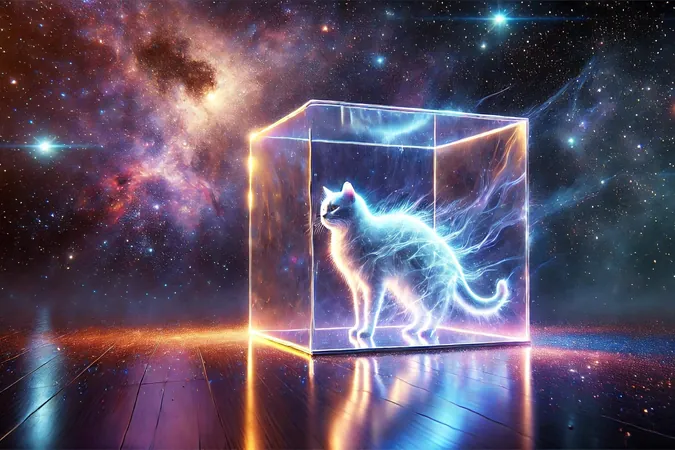
Scientists Unveil Groundbreaking Theory: Universe Self-Collapses to Solve Schrödinger's Cat Dilemma!
2025-07-10
Author: Ken Lee
In the bizarre realm of quantum mechanics, particles can exist in multiple states at once, a phenomenon known as superposition. But in our everyday reality, things adhere to the solid, predictable laws set forth by classical physics, leaving scientists questioning: How does the universe transition from quantum freakiness to classical normalcy?
A team of researchers led by Matteo Carlesso from the University of Trieste believes they’ve cracked this mystery. Their fresh study, featured in the Journal of High Energy Physics, presents a reimagined version of quantum mechanics that illustrates how the universe could shift smoothly from its enigmatic beginnings into the orderly cosmos we witness today.
The Shift from Weird to Normal: A New Perspective
Traditionally, quantum mechanics posits that particles remain in a superposition of states until measured. But what exactly constitutes a 'measurer'? This question has fueled perplexing thought experiments like Schrödinger’s cat, where a cat inside a box is paradoxically both alive and dead until someone opens the box. Carlesso's research challenges this outdated viewpoint.
The research team proposes that systems can collapse into a single state on their own, thus removing the need for an external observer. They argue that larger quantum systems could spontaneously settle into a stable state, bypassing the bizarre effects that define smaller quantum particles. To support this idea, they modified the famous Schrödinger equation by introducing new terms that incorporate randomness and self-interaction.
Explaining the Cat: Moving Beyond Superposition
The researchers zeroed in on the early moments of the universe when space and time might have existed in a multitude of states simultaneously. However, today, the universe behaves classically, with smooth space and continuous laws. Carlesso’s model uses the Friedmann-Lemaître-Robertson-Walker (FLRW) cosmological model to explain how the universe’s chaotic beginnings could collapse into a predictable form, negating the need for an outside observer.
"Our model describes a quantum universe that eventually collapses, becoming effectively classical," Carlesso explained. This transformation would have occurred prior to the release of the Cosmic Microwave Background (CMB), which already exhibits classical characteristics.
A New Dawn for Quantum Theory: Solving Old Paradoxes
By proposing spontaneous collapse, this new framework tackles the enigma of Schrödinger’s cat head-on. Instead of the cat existing in a limbo of alive and dead, the revised model allows for systems—whether atoms or galaxies—to collapse naturally into a definite state over time. "Every system localizes spontaneously in a particular state," said Carlesso, reinforcing that the universe itself underwent this collapse, resulting in its current form.
This phenomenon reveals a critical insight: larger systems are more likely to collapse quickly. Thus, while subatomic particles can linger in superposition, their interactions with larger entities force them to adopt clear, classic properties.
Testing a Revolutionary Hypothesis
Though this theory is compelling, verifying it presents a major challenge. The predicted effects of spontaneous collapse are minuscule, particularly for atoms and molecules, and require highly sensitive experiments to detect.
Currently, Carlesso and his collaborators are teaming up with experimental physicists to put their ideas to the test. Their goal is to uncover subtle deviations from established quantum behavior, and even minor evidence could lend credibility to this revolutionary theory.
While the research may not forecast dramatic cosmic spectacles, it provides a robust framework to comprehend the universe's formative behavior. If validated, it could fundamentally reshape our understanding of how the classical world emerged from its quantum origins. Finally, there might be a coherent explanation for why, regardless of those strange quantum rules, cats can only be alive or dead—but never both!


 Brasil (PT)
Brasil (PT)
 Canada (EN)
Canada (EN)
 Chile (ES)
Chile (ES)
 Česko (CS)
Česko (CS)
 대한민국 (KO)
대한민국 (KO)
 España (ES)
España (ES)
 France (FR)
France (FR)
 Hong Kong (EN)
Hong Kong (EN)
 Italia (IT)
Italia (IT)
 日本 (JA)
日本 (JA)
 Magyarország (HU)
Magyarország (HU)
 Norge (NO)
Norge (NO)
 Polska (PL)
Polska (PL)
 Schweiz (DE)
Schweiz (DE)
 Singapore (EN)
Singapore (EN)
 Sverige (SV)
Sverige (SV)
 Suomi (FI)
Suomi (FI)
 Türkiye (TR)
Türkiye (TR)
 الإمارات العربية المتحدة (AR)
الإمارات العربية المتحدة (AR)